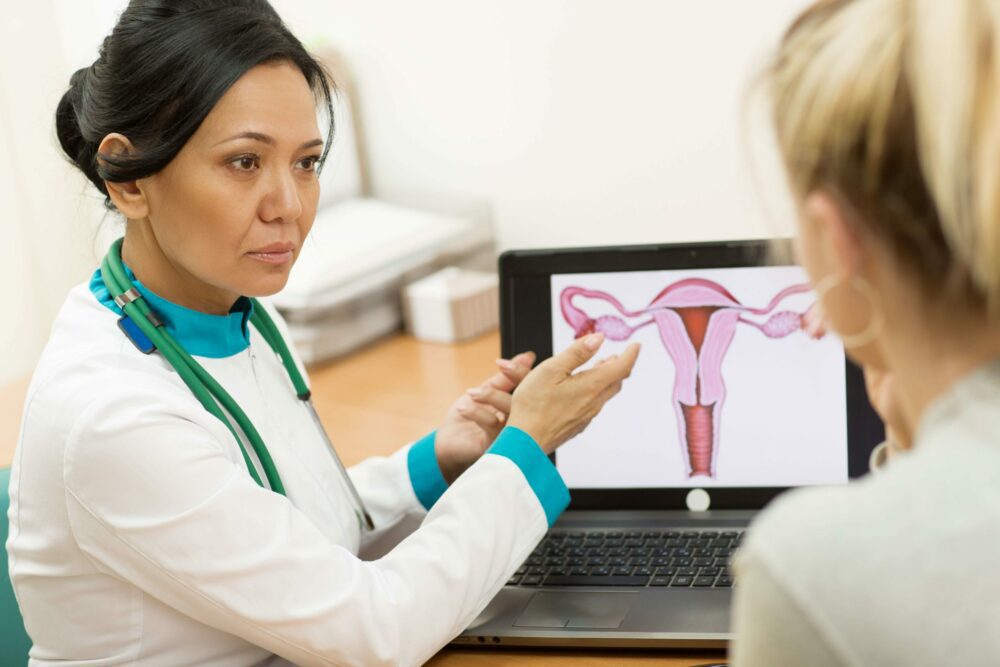Adenomyosis Versus Endometriosis


- Adenomyosis and endometriosis both occur when endometrial tissue grows abnormally.
- Endometriosis is when the tissue, normally found in the lining of the uterus, implants and grows elsewhere in the body.
- Adenomyoisis us when this endometrial tisssue grows deep within the muscular wall of the uterus.
Normal endometrial tissue thickens each month in preparation for implantation of a fertilised egg. If this does not happen, the tissue breaks down and is shed from the body as monthly menstrual flow. The problem with endometrial cells growing in other locations is that they undergo the same process of expansion each month, but the excess tissue has nowhere to go, so it accumulates, frequently causing inflammation, pain and discomfort.
Parts of the body affected by adenomyosis and endometriosis
Adenomyosis usually causes an enlarged uterus, which may be palpable during a pelvic examination. Endometriosis might also cause palpable masses, but the location of these will depend on the part of the body affected by the condition. Endometriosis is usually confined to the pelvic region, but has been identified in the abdomen, the thoracic cavity, the gastrointestinal tract and the urinary tract.
Symptoms
The symptoms of adenomyosis and endometriosis can be similar, both causing dysmenorrhoea, chronic pelvic pain and in some cases infertility. The gold standard approach for definitive diagnosis of endometriosis is laparoscopy; although transvaginal ultrasound is being used with increasing frequency to diagnose cases of deep endometriosis, such as those affecting the ovaries and bowel. Transvaginal ultrasound is also the preferred method for diagnosing adenomyosis.
Incidence
Due to the high number of asymptomatic patients with adenomyosis (30-50%) and endometriosis (20-25%), obtaining an accurate incidence rate for either is difficult. Estimates put endometriosis incidence at 6-10% and adenomyosis incidence at 9%. There is a high degree of comorbidity, with one study identifying adenomyosis in 70% of women with endometriosis. To date, endometriosis is the better understood of the two conditions. Until the advent of the transvaginal ultrasound, adenomyosis was usually only diagnosed by examining the excised uterus following a hysterectomy. Knowledge on the condition and the impact it has on fertility and pregnancy is growing.
Nabta is reshaping women’s healthcare. We support women with their personal health journeys, from everyday wellbeing to the uniquely female experiences of fertility, pregnancy, and menopause.
Get in touch if you have any questions about this article or any aspect of women’s health. We’re here for you.
Sources:
- Kunz, G, et al. “Adenomyosis in Endometriosis – Prevalence and Impact on Fertility. Evidence from Magnetic Resonance Imaging.” Human Reproduction, vol. 20, no. 8, Aug. 2005, pp. 2309–2316., doi:10.1093/humrep/dei021.
- Osayande, A S, and S Mehulic. “Diagnosis and Initial Management of Dysmenorrhea.” American Family Physician, vol. 89, no. 5, 1 Mar. 2014, pp. 341–346.
- Adenomyosis. Mayo Clinic, 8 June 2018, www.mayoclinic.org/diseases-conditions/adenomyosis/symptoms-causes/syc-20369138.
- Endometriosis. Mayo Clinic, 24 July 2018, www.mayoclinic.org/diseases-conditions/endometriosis/symptoms-causes/syc-20354656.













































